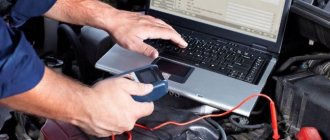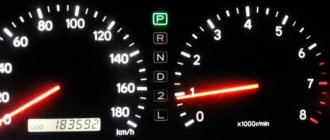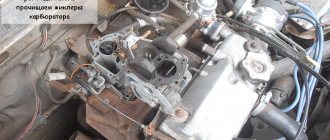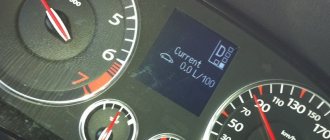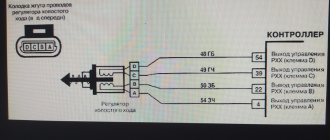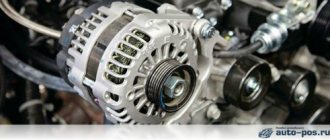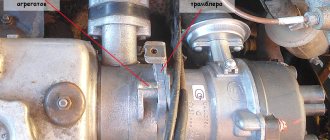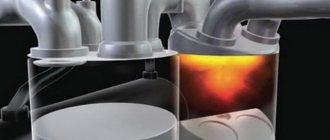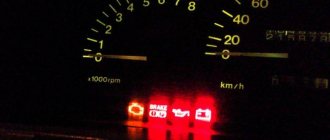The car is shaking, what should I do?
At the first stage, the machine is diagnosed. Let's say that you have a Niva with a carburetor engine in your garage. Your car already shows signs of “illness” at the first stage of movement. Or the car started moving without any hassle, but when a certain number of revolutions was reached, the engine malfunctioned. All this will not give answers, but only creates questions, because anything can break. In any case, if unstable operation of the car’s power unit is noticed while pressing the accelerator pedal, the first thing you should do is:
- Check air and fuel filters. The supply of air and fuel to form a combustible mixture will be difficult if these elements are heavily contaminated.
- Check the fuel pump. Its incorrect operation leads to unstable fuel supply.
- Check fuel pressure. The supply of the fuel-air mixture under insufficient pressure often leads to jerking of the car. The pressure when the engine is running should not exceed 3 kgf/cm2.
Most of the reasons lie in the car's fuel system.
The accelerator also cannot be discounted
At the moment when the driver sharply presses the accelerator pedal, there is a rapid increase in crankshaft revolutions. However, this may cause the vacuum ignition angle regulators to malfunction. Ultimately, the distributor lags at low speeds, and the car begins to jerk.
As the crankshaft speed increases, the engine needs to work faster, igniting and admitting the fuel-air mixture. However, if there are problems with the vacuum regulators, there may be problems with opening the throttle valve and it will not be possible to quickly increase the speed. As a result, gasoline burns at the wrong time, which can damage the bearing responsible for the ignition timing.
To confirm or refute the problem when the VAZ-2114 jerks while driving, it is worth checking the vacuum regulators. Diagnostics is done like this: before starting the engine, you should remove all the pipes with hoses, first covering them with your hands. While the engine is running, you can hear the retractor effect of the regulators.
https://www.youtube.com/watch?v=ytpressru
However, if a vacuum does not form during the working mixture, then the cause of the leakage lies precisely in the damper. The element needs to be replaced.
We eliminate jerks when the car starts moving
According to the number of reviews from owners of a Chevrolet Niva with a carburetor engine, it is the engine power system that most often poses a problem. Due to the breakdown of absolutely any element of the system, the stable process of fuel combustion in the cylinders can be disrupted. If an insufficient amount of mixture enters the cylinders, then the car in such conditions will not be able to produce the required power. Against the background of this problem, twitching will begin to appear.
Check the pipes, determine if there is any depressurization of the system. Measure the fuel pressure. If the indicator does not correspond to the norm, then further search for the cause should be sought in the pressure regulator, fuel pump. These actions must be performed not only with the carburetor system, but also with the injection system. If an injector is installed on the Niva 21214, then in this version the ignition system is also connected. The cause of the car jerking can be absolutely any sensor that has failed. Perhaps in this case you will need the help of specialists, because all the work is complicated by the presence of an electronic unit.
Where to look for the reason
Often the cause of accelerator pedal dips is a drop in pressure in the fuel rail. For an injection car, the pressure in the ramp is considered normal at 2.8-3.2 Bar.
It is imperative to check the functionality of the sensors involved in the process of mixture formation and fuel supply to the cylinders, namely the throttle position sensor (TPS) and the crankshaft position sensor (CPS).
Failures in their operation will certainly lead to this problem. It would also be a good idea to check the performance of the injectors.
All these elements can be checked at home; it is enough to have a regular pressure gauge and multimeter on hand. With their help, the pressure in the ramp is first checked, and then the indicated sensors. Injectors are tested on special stands.
Eliminate jerking when accelerating a car
If the Niva 21214 begins to twitch when accelerating, then in this case it is necessary to carefully check the engine power system. The driver presses the speed pedal while driving, but the vehicle does not accelerate. By pressing the accelerator pedal, the driver provokes an increase in the amount of fuel mixture supplied to the cylinders. If this does not happen, breakdowns occur in a uniform manner.
We check all filters: fuel, air. A carburetor engine has 2-3 filters. We will not take into account the mesh in the neck, since it can only prevent the penetration of large particles. You should carefully check the filter that goes to the fuel pump. Often it becomes clogged with impurities, which ultimately prevents the free flow of fuel, causing the engine to starve.
Eliminate jerking when the car is moving steadily
If a Chevrolet Niva or Niva 21214 exhibits twitching during stable movement, this most often happens due to problems with the ignition system. You can often hear car owners complaining that they just installed new spark plugs, but the engine has already failed. Detonation can occur even with new spark plugs due to incompatibility with the engine. If the spark plug fails, then the fuel will not burn completely, and breakdowns will begin in the operation of the power unit.
Features of the manifestation of the malfunction
Before accurately determining the cause of the breakdown, you need to observe your car. If you feel jolts while driving, then when you stop, you may not be able to detect the malfunction. The malfunction manifests itself as follows:
- jerking during acceleration;
- jolts when the gas pedal is pressed at a constant speed;
- troubles when activating or disengaging the clutch;
- The car jerks when braking.
In the last two cases, the fault should be looked for in the clutch. In others, the problem may be hidden in many components: the spark plug group, the fuel system, ignition, carburetor operation. During diagnostics, it is necessary to note the conditions under which problems occurred in the vehicle. For example, malfunctions of the fuel pump occur at high engine temperatures, at low speeds, or during hot summer weather. The shocks appear in this case due to the “vapor lock”.
Fuel system malfunctions
The quality of fuel in our country leaves much to be desired. Due to high prices for fuel and lubricants, many drivers are trying to save money. They buy fuel by hand, at small gas stations. You shouldn't expect high quality from cheap gasoline. For this reason, if the car moves jerkily, then you need to pay attention to the fuel supply system:
- Most often, the car starts to move jerkily if you have poured low-quality fuel into the tank. If at the time of refueling the tank was almost empty, then you will notice the problem almost immediately after replenishing the fuel supply, and the exhaust gases will become very dark. If there was already gasoline in the tank, then the car will cover part of the distance calmly. The confusion can only be eliminated by using high-quality fuel; you can dilute gasoline with another, high-quality one. If this does not help, then you need to flush the fuel system.
- If you have not used your car during the winter, then in the spring you may feel jolts when accelerating due to condensation in the gas tank. As a rule, the engine does not stall for long.
- The problem can arise due to untimely replacement of the fuel filter. If there is excessive clogging, the fuel pump will not operate smoothly. The situation can be corrected by replacing the filter with a new one.
- As the engine and ambient temperatures rise, the fuel pump creates “vapour locks”. You can only get rid of them if you reduce the temperature of the pump. Wet the cloth and place it on the unit.
Why does the VAZ 2107 jerk?
When the driver discovers that the VAZ 2107 car is twitching, first of all there is a feeling of wariness and, of course, this is terribly annoying.
Usually, a visual inspection of the engine does not bring any results. To identify the cause, it is necessary to determine under what conditions the car jerks.
The most common options are:
If the VAZ 2107 car jerks periodically in the 2nd and 3rd cases, then you need to pay attention to the operation of the clutch and its condition. Other cases may be harbingers of a wide variety of malfunctions.
Malfunctions of the carburetor and other systems
The second most popular system that fails in the VAZ-2107 is the carburetor.
- First of all, check the idle air valve and jets. The valve needs to be replaced and the jets cleaned. Buy only high quality components so that they do not break down quickly.
- The second common malfunction of the carburetor unit is air getting into it. The place where it is sucked in can be found by visually inspecting the hoses. Most often, the thin hose of the vacuum corrector loses its seal. Many technicians recommend simply replacing all the hoses, since air can enter the carburetor through microcracks.
After checking the fuel system and carburetor, you need to pay attention to the distributor. Be sure to check the quality of the ignition contacts that distribute the impulse to the spark plugs. If the contact burns out, the engine will “triple”, “double”, and jerking will be felt while driving.
If you do not find a malfunction here, then check the spark plug wires. Experts recommend changing them, like carburetor hoses, at the slightest suspicion. Usually the problem is hidden in insulation breakdowns, which may not be visible to the naked eye. When inspecting and checking the wires, pay attention to the ignition coil and its wire.
In the rarest cases, the car may move jerkily due to the spark plug failing soon. Typically, this behavior is unusual for this element of the ignition system, but car mechanics sometimes encounter this problem. The fact is that before failure, the spark plug begins to spark randomly, creating failures in ignition. The engine reacts to this with jerks and uneven running. Modern spark plugs most often do not behave this way; spark problems occur with inexpensive options with low quality.
Characters without spaces – 4468
Uniqueness of ETHT – 98%
Uniqueness of Text.ru – 100%
Academic nausea Advego–7.5%
Advego word frequency – 1.61%
Sometimes it happens that when driving, the car begins to twitch when the speed increases or when driving at a steady pace. At these moments, the driver can “boil” no worse than the engine itself. Moreover, when stopping and externally inspecting the engine, everything may look absolutely normal. The only correct behavior in this case is to drive and listen to the engine.
But for an inexperienced motorist, it is difficult to understand from the sound of the engine what is wrong with it. Therefore, below are the main reasons for this engine behavior and methods for eliminating them.
Determining the location of the breakdown
First of all, you should make sure that it is the VAZ 2107 carburetor that creates the failures, after which you can disassemble it and take measures. Failure in engine operation with a sharp increase in speed can also be caused by parts of other components:
- bad spark plugs;
- malfunction in the contact ignition system.
Typically, worn-out spark plugs do not fail immediately, but die out as the pressure in the cylinders increases. That is, at idle and low speeds the spark plug produces a normal spark, but at high speeds, when the piston manages to create high pressure, the spark appears every once in a while or disappears altogether. The same effect is observed when the throttle valves are opened sharply: the pressure in the cylinders increases, the spark goes out, and the car, instead of dynamic acceleration, goes into failure.
It is quite simple to make sure that dips appear due to candles. When you do not have the opportunity to test them under pressure, you need to replace them with a working or new set, and then check the “classics” on the go.
If everything is in order with the spark plugs, in cars with a contact ignition system you need to check the distributor elements, which may cause failures:
- Make sure that the contacts are not burnt and clean them with a file. If a recess has burned out on one of the contacts, and a protrusion has formed on the other, then the part must be replaced.
- Check the operation of the ignition timing vacuum diaphragm connected to the carburetor by a tube. You should remove the distributor cap and disconnect the tube from the carburetor, and then draw air through it with your mouth. A working diaphragm will sharply pull the contact group towards itself using a lever.
- Check the play of the bearing on which the contact group rotates. To do this, you should manually rock the area where the contacts are installed. If play is felt or, conversely, the platform does not turn, it is necessary to change the bearing.
An important point: failures are more often caused by the spark plugs and the ignition system than by the carburetor, so it is recommended to check them first. When the diagnosis of the listed elements does not give a positive result, you can safely move on to the carburetor.
Carburetor VAZ 2107 jerks during acceleration - reasons and ways to solve this problem
As a rule, the root of this problem can be a very limited number of factors, which manifest themselves in the following:
- Shocks when accelerating a car. When you press the gas pedal, the engine begins to sneeze, jerk, or lose power.
- Jerks when driving at one speed. During a measured drive at one speed, the engine begins to cough, twitch or trip.
- Unpredictable behavior when operating the clutch.
- Jerks when braking.
Naturally, the most interesting from a repair point of view are the first two cases. A large number of factors can provoke this behavior, but all of them, as a rule, are associated with incorrect operation of the fuel system or misfires. And so about everything in order.
“Failure” when pressing the gas pedal:
It is better to use it as is, if it is installed standard on your car.
What is the best way to use the return line as it is or to install a tee in front of the fuel pump?
I noticed that such nonsense often happens due to a clogged or muffled return line, the fuel pump pushes the needle of the needle valve and a small but overflow is formed. Basically, this is on an almost worn out valve or from new repair kits produced in the basement, it is unclear where and it is not clear by whom:((. At idle speed it is not there, there is no overflow even when the engine is turned off, excess pressure is created by the fuel pump when the engine speed begins to rise, with a further increase in the level stabilizes due to higher flow.
Everything is told correctly. Reasons and actions.
If implied. that the new carburetor matches the engine and is fully configured and connected correctly, then most likely the problem is in the fuel supply (clogging in the fuel line, faulty fuel pump) or in the ignition system (advance angle, spark plugs, “breaks to ground somewhere”). And also “suction” of air under the carburetor.
And if the new carburetor fails, tell me what to do
The Solex 21083 carburetor continues to amaze owners to this day. It is characterized by a large number of malfunctions that can be eliminated in a garage environment. One of these problems is the failure of the Solex 21083 carburetor when pressing the gas. Let's look at this problem in more detail and describe ways to fix it.
Problems with the fuel pump
During diagnostics, you should take into account the conditions under which engine malfunctions occurred - when was the last refueling, air temperature, duration of the trip, time of year. All these factors can play a decisive role in further diagnostics, save the technician from unnecessary work and significantly save time.
For example, problems with the fuel pump can occur if it overheats during a long drive or very high temperatures outside, or when driving at very low speeds. In such cases, vapor locks may form in the pump, which can only be eliminated by cooling the unit. The resulting blockages interfere with the operation of the vacuum fuel pump and prevent it from fully pumping gasoline into the engine. This is one of the most common diseases on similar VAZ models and only replacing the unit will help eradicate it. In the case when a problem arose in what is called “in the open field” and you need to get to the nearest populated area. Regular cold water will come to the rescue. She should water the gas pump or wet a piece of rag, wrap it around the knot and wait a little. After the unit cools down, the car will start and behave absolutely normally.
Remarkable . That in some cases, in the absence of water, urine can be used as a substitute. Yes, this is not a joke! In emergency situations, this method has already helped out many motorists.
Messages 10
1 Topic by Jungle 2015-12-29 20:10:33
- Jungle
- Participant
- Inactive
- From: Unecha
- Registration: 2014-03-11
- Messages: 130 Thanks : 14
- Car: VAZ 2111 1.5i 16v
Topic: Resolved: Engine idles rough, jerks at low throttle
Hello everyone! I understand that there are many similar topics, but they did not help me, I ask for help with my problem. It all started 3 days ago after a long trip to
300 km, the engine began to tune up at idle, it pulls and drives normally, but when driving with low gas (at low speeds) it jerks. I rechecked everything: I installed working spark plugs, tried installing a new MZ, DPKV, IAC, DMRV, checked the DD, DPS, BB, the marks were set, the pulleys were tightened, I changed the gasket under the intake manifold, I installed new rubber bands between the receiver and the manifold, I measured the fuel pressure - in normal, the pump pressed the return line and showed 6 atm - normal, the mesh in the tank is clean, I cleaned the remote control recently, compression in all cylinders
12.7 atm, no gusts are visible on the air pipes and breathers, the onboard display does not display any errors. When I ran out of ideas, I went to the diagnostician. After 1 hour of dancing with a tambourine near the car, he threw up his hands, saying everything was fine and didn’t know what the fuck was wrong with my car. There is only hope for you, help! I am attaching a video for better clarity. [video]
Source
Fuel quality
In the case where such a problem arose shortly after refueling and it is not relatively hot outside. Almost one hundred percent the root of evil lies in the quality of the fuel poured in. If low-quality gasoline was poured into an almost empty tank, such symptoms appear almost immediately. In this case, to compensate for the negative effect, you can add high-quality fuel to the tank and thus dilute the surrogate. Then you can continue driving on this “fuel” until it is completely used up.
Carburetor malfunction
The first step is to check the idle speed valve and fuel jets. The whole thing needs to be thoroughly cleaned and blown out.
The second reason, as a rule, is the entry of excess air into the system. In this case, you should carefully inspect all hoses for cracks or abrasions. The problem is eliminated by replacing damaged fuel and air hoses.
Failure in the ignition system
If no problem is found in the fuel supply system, you should look for it further - in the ignition system. The first thing you should always do is check that the distributor is working properly. The quality of contacts and those responsible for supplying high-voltage pulses to the spark plugs. If these contacts burn, the operation of the motor may be disrupted and an effect may occur when the engine triples or doubles.
If everything is fine with the distributor, you need to check the condition of the high-voltage wires on the spark plugs. In the event of an insulation breakdown, they can have this effect.
Separately, it is worth diagnosing the ignition coil and its wires. In some cases, the problem may be located there.
In very rare cases, it happens that a spark plug, which can be said to be “on its last legs,” can produce a spark in a chaotic manner, which also negatively affects the operation of the engine.
For engines with an injector, the causes of malfunctions may be identical to those for carburetor engines. And eliminating these problems is done in the same way. In addition to possible malfunctions in the electronic components of the injector. Then you cannot do without accurate diagnostics of all electronics.
When the car jerks when braking, pressing or releasing the clutch pedal, this indicates possible wear or damage in these systems. These defects are eliminated through inspection and revision.
Diagnostics
Checking the power plant is done in this way.
Fastenings
Check that all bolts are in place and that they are tightened. Sagging cushions and loose axles in 60% of cases provoke the transfer of vibration to the body, imbalance of the internal combustion engine.
Fuel system
Checking the fuel lines is necessary to eliminate air leaks. Leaked bubbles are the primary source of interruptions in the normal engine stroke. For example, on a VAZ 2110 the “sore” is located in the fastenings of the fine fuel filter. It is also necessary to diagnose the carburetor or injector. A grain of sand stuck in an injector or jet prevents the normal flow of gasoline and disrupts the operation of the installation.
Bad fuel
Low-quality fuel is a common cause of car jerking and instability of engine speed. This usually appears a short time after refueling. The problem can only be solved by draining the fuel and flushing the entire system.
Engine
The next common problem is wear or incorrect adjustment of the main components of the power plant. Clogged strokes, a worn piston group or broken bearings can cause more than just jerking of the machine.
The problem of feeding the engine with the fuel-air mixture
Also a common reason for visiting a service station. Problems in the fuel and air supply system guarantee an unstable supply of the mixture to the combustion chamber. The result is a jerking of the car, floating speed of the power plant.
The problem can be resolved by diagnosing all elements of the fuel line, replacing filters, and checking the functionality of the fuel pump.
Engine management system
The following problem is relevant for vehicles equipped with an ECM. Sensitive electronics often malfunction due to wetness, mechanical damage, system errors, or incorrect sensor readings.
